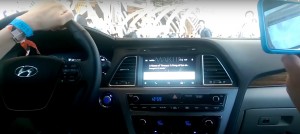 The sophistication, variety, and integration of in-car entertainment and operating systems is ever-growing, as any driver can tell you. Voice-activated systems that sync with your mobile phone or tablet over Bluetooth and integrate with its onboard multimedia and data now come as standard on newer models, and however proprietary the auto manufacturer’s user interface and onboard software are, they’ll almost always work seamlessly with the Android and Apple gold mobile standards . For eager consumers of audiobooks, then, in-car book listening is going to arise as an almost natural choice at some time. But how to do it safely? And is it safe in the first place?
The sophistication, variety, and integration of in-car entertainment and operating systems is ever-growing, as any driver can tell you. Voice-activated systems that sync with your mobile phone or tablet over Bluetooth and integrate with its onboard multimedia and data now come as standard on newer models, and however proprietary the auto manufacturer’s user interface and onboard software are, they’ll almost always work seamlessly with the Android and Apple gold mobile standards . For eager consumers of audiobooks, then, in-car book listening is going to arise as an almost natural choice at some time. But how to do it safely? And is it safe in the first place?
Overall guides on safe setup of Android and Apple systems for in-car use are widely available. I’ve linked to a couple of generic guides in the preceding sentence. Once your system is linked to the car’s audio, it’s easy enough to use Apple’s Siri or Google Now to open multimedia apps and sift through their libraries. Apple’s Siri user guide even includes “Shuffle my Road Trip playlist” as a standard example voice command.
As the major mobile OS players push into the in-car software arena with their own projects, like Apple’s CarPlay or Android Auto, some manufacturers are offering these as onboard options. Should you be worried that you will be locked out of the Apple walled garden in your auto buying choices if you’re an Android user? Unlikely. It appears that most manufacturers are offering either major platform as standard, rather than restrict themselves to one and screen other auto buyers out.
When it comes to the specifics of audiobooks, Audible is the audiobook app of choice across all platforms, and handsfree operation features fortunately now come as standard. For Kindle users, as explained here, since this summer “the audiobooks offered by the Amazon subsidiary can be read aloud by the Echo digital assistant. With just your voice, Amazon Echo can be cued to read a book. The digital assistant can also be told to move to different places throughout a book.” Audible provides its own advice on how to listen to its audiobooks in cars, and also has integrated Apple’s CarPlay into its iOS app, and plans on its own dedicated CarPlay app. (And you can see an example in the picture for this article, taken from Audible’s own video of its participation in Android I/O 2015.)
With the how-to aspect of this issue (hopefully) safely out of the way, we shift to the issue of whether you should set up your vehicle for in-car audiobook listening. This question, naturally enough, hinges on the issue of distraction. The Royal Society for the Prevention of Accidents (RoSPA), the UK’s most influential road safety body, has released a fact sheet on driver distraction (based admittedly on fairly outdated AAA Foundation for Traffic Safety research), which finds that “manipulating music/audio controls” is one of the commonest types of driver distraction, done by 91.4% of its driver sample. “Talking on a mobile phone,” one of the favourite bogies of road safety campaigners, is in fact done by only 30% of drivers, while “conversing” distracts over 77% of drivers. Interestingly, 40% are distracted by “reading or writing.”
When it comes to the amount of time that the distraction consumes, however, the study finds that conversation is the worst offender, consuming over 15% of total driving time. The other distractions take up only fractions of time in comparison. And listening to music or audio, often advocated as a life saver for drowsy drivers, is not listed as a distraction at all.
“In-Vehicle technology can be distracting, especially if there are several systems in the same vehicle,” adds RoSPA. “Never put too many different devices in a vehicle. If you can change the settings on the technology, then find ways of using it that is less distracting.” So, if you are using audiobook audio in-car, set up your devices for handsfree/voice operation as far as you can.
And in fact, there are persuasive reasons why you should do just that, especially for long drives. According to the AAA Foundation for Traffic Safety’s annual Traffic Safety Culture Index, based on a study conducted in November 2014, “more than a third of drivers report having fallen asleep behind the wheel at some point in their lives,” and furthermore, “drowsy drivers are involved in an estimated 21% of fatal crashes.” Now, almost any incidental risk involved in listening to and managing audiobooks while driving is likely to be far less critical than that statistic. Listening to that captivating bestseller on a long night drive could do more than enlarge your mind – it could save your life.
(p.s. There’s one further, though not especially dangerous, hazard in listening to audiobooks while driving, as reported in Forbes. One Forbes Associate Editor apparently became so absorbed in Stieg Larsson’s Girl With The Dragon Tattoo that he drove two hours in the wrong direction while following the twists and turns in the plot. Responsible listening, people …)
(p.p.s. I hope there is no need to include the standard “Teleread accepts no liability …” disclaimer here, but it should be obvious that the tips and recommendations here are for your guidance only, and should be applied with reference to authoritative material from other sources, and to your own common sense.)


































In low-traffic highway driving, it’s reasonably safe to listen to an audiobook while driving. If you’re in a lot of traffic and/or driving in the city, it’s a really bad idea. Contrary to what CW says, human brains do not multitask. They aren’t wired that way. The “Invisible Gorilla” is a thought-provoking study to consider.
I’m concerned that picture has the steering wheel on the wrong side of the car for someone writing a story in the UK. What if it causes someone going on vacation (or “holiday”) over there to unwittingly drive on the wrong side of the road? 🙂
@Chris: Warning served! 🙂 Besides, TeleRead community members are a pretty savvy bunch. Furthermore, last I knew, Paul was based in Hungary even though he is the quintessential Scot. David